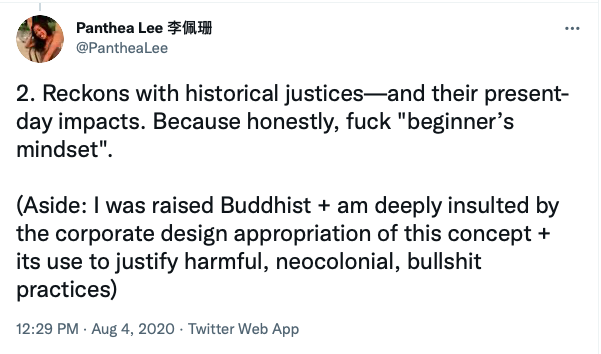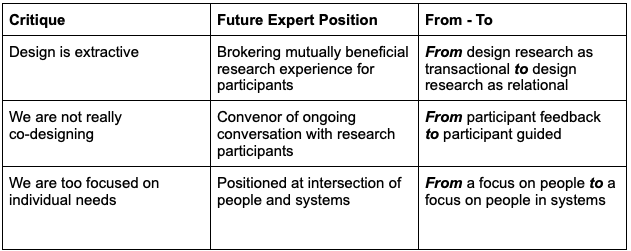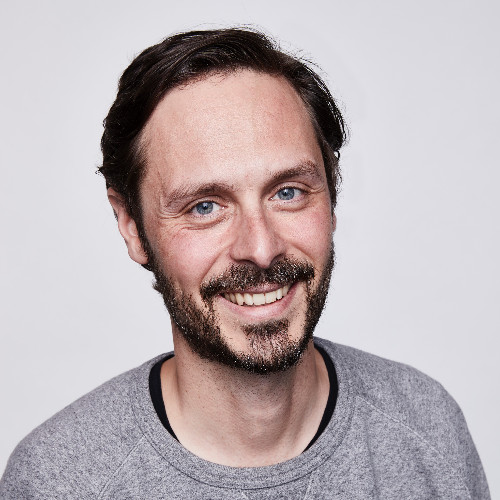Over the past couple of years, I have listened closely to conversations about how product and service design plays a role in perpetuating inequity in society. And at the heart of what I hear from practitioners and scholars is that so often, the people most impacted by design are not the ones influencing design decisions.
Some of the prominent voices that have helped me explore how design practice can perpetuate inequity include the Design Justice Network and the nonprofit Creative Reaction Lab. Both have defined principles and practices around community-led design that “center people who are too often marginalized by the outputs of design.” By placing community members at the core of the design process, community-led design redefines who gets to be the expert, with the professional designer shifting from having editorial and creative authority to occupying a position where they work alongside community members as a facilitator and a thought partner.
While community-led methodologies feel like the standard when it comes to designing for equitable outcomes, I regularly hear frustration from industry practitioners who point out that the pace of projects in for-profit design settings feels incompatible with the time needed to organize and engage stakeholders in a community-led design process.
Feeling this frustration myself, I decided to explore different decision moments in the for-profit design context where my expertise and authority might be reimagined and repositioned in a way that addresses designing for equitable outcomes. I looked for inspiration in design scholarship as well as prominent critiques of assumptions that drive the design process, in particular design thinking. Drawing on the literature and prominent critiques, I explored three shifts that I can make in my practice as a designer that reimagine how I show up as an expert and decision maker.
Mindset Over Method
Before getting into the three shifts, I want to highlight one big “aha” moment I had when I started thinking about how designers in for-profit settings navigate this tension between time constraints and process. I started by looking at the history of the Scandinavian Workplace Democracy Movement out of which emerged the practice of participatory design (PD). In the context of the Scandinavian Workplace Democracy movement, PD approached the design by bringing workers and managers together to define the tools of the trade and working environments rather than leaving those decisions to managers alone. What I found most interesting is that this movement was not defined by a specific set of methods, but rather, as design scholar Judith Gregory highlights, it was understood as a “political commitment to societal concerns and relationships with participating users and communities.”
This idea of a “political commitment” as the unifying thread of PD gave me a sense of relief and permission. It helped me realize that, while methods and processes are indeed important, what is essential for changing how we design is having a commitment to an objective, a mindset, and a motivation that can help us reflect on and critique how we do our work. In the case of the Workplace Democracy Movement, this objective was about changing the power dynamic between designers and those designed by redefining who got to be the expert decision maker in the design process. And by redefining the role of expertise in design, the participatory design created new pathways for more equitable outcomes.
Out of this aha moment came a lens for critiquing moments in my practice where I change how I show up as an authority and a decision maker. This slightly more abstract and less tactical approach to thinking about community-led design relieved me from getting hung up on seemingly incompatible technical aspects of these methods in a for-profit context and instead offered a generative prompt to redefine and repurpose how I do my work.
Assumptions and shifts for expertise in design
What follows are three big critiques of commonly held assumptions that drive the design process, design thinking in particular, and the corresponding mindset shifts that are emerging around these critiques. This list of assumptions, critiques, and shifts is by no means exhaustive, but it has provided a starting point for how I approach pushing the boundaries of who gets to make important decisions in the design thinking process.
Assumption #1: Design impact is the value exchange with the people we learn from in research
“A significant portion of innovation is actually done by users, rather than manufacturers…those whose needs have long been marginalized within the matrix of domination have a strong information advantage when it comes to articulating those needs and developing possible solutions.” Sasha Constanza-Chock, author of Design Justice
Constanza-Chock’s quote hits home for research and design taking place not just in the industry, but in academia as well. Prior to working in the industry, I worked at a nonprofit organization and then went to academia. From both settings, I often saw academic researchers parachute into a nonprofit organization, take up the time of the busy employees, and then take what they learned and leverage that into a publication and grant funding. The organization might receive a modest donation while data from the research would help drive the researcher’s tenure and promotion and support grant applications that brought money and opportunities to the school. Sometimes findings from that research were shared back with the nonprofit, but this was not always the most symmetrical value exchange.
Shift #1: Go from transactional to mutually beneficial engagement in research
Reacting to the asymmetrical research relationships between academic institutions and community-based organizations, Liat Racin and Eric Gordon created the MOU for mutually beneficial research, a template that researchers and research participants co-create to establish terms of engagement where both parties might benefit more equally from the experience. Examples of prompts include how data is shared, how it is used, and what a longer-term relationship might look like.
An analogous example to Racin and Gordon’s MOU is the Chicago-based engagement journalism organization City Bureau. At City Bureau, journalists don’t parachute into neighborhoods, gather stories, and leave. Rather, City Bureau has a permanent physical presence in Chicago’s Southside where, on a weekly basis, residents of the neighborhood show up and pitch news stories to the reporters. And rather than taking the ideas and writing a story, the reporters ask residents if they are interested in collaborating on writing the story. In this model, two things are taking place that breaks the historically transactional model that shapes journalism: First, residents of a neighborhood are shaping the narrative of their neighborhood through a greater editorial agency, and second, they are entering a relationship where they can learn a new skill.
What examples like the MOU for mutually beneficial research and City Bureau highlight is a need to check assumptions about what research participants view as valuable. Indeed money may be very well-received, but offering more possibilities or even a moment to explore alternate outcomes may help to reframe our decision-making process for how we engage people in research. For example, do research participants want to learn how to be researchers themselves? Do they want to hear about the findings when the work is finished? Pushing past the assumptions about what people want from participating in research creates a dynamic where people can participate in research on their terms, rather than the narrowly bounded terms of a researcher.
Assumption #2: Co design gives people agency in the design process
As with many social movements, ideas and principles often get coopted and watered down. In the context of participatory design, this watering down of how we meaningfully engage people in design is captured by Shannon Mattern’s research on the failed Sidewalk Labs initiative in Toronto. In her article in Places Journal, Mattern describes how the efforts to build a smart city replete with sensors from the ground up failed after the company was unable to engage residents and build trust through the design process. Mattern points to Sidewalk Labs’ attempt at co-creating the future of the city through what can be described as an arms-length co-design process. A gallery space was opened where the company left questions and design ideas for residents to react to. The extent of the engagement, as Mattern writes, was relegated to asynchronous conversations through Post-it Notes. For Mattern, this amounted to the performance of co-design, creating an illusion of community input that, in the end, residents did not buy.
Mattern’s story reflects broader criticism levied against co-design and how it is used as a form of research theater, where designers create an appearance of engagement that in reality gives participants very little agency over influencing the design process.
Shift #2: Move from gathering participant feedback to being participant-guided
When I worked at IDEO, I led a project where my colleagues and I worked with a college to bring their curriculum online. The curriculum was very hands-on and relationship-driven, so bringing it online brought up concerns from students and faculty that the experience would suffer in a digital setting. Recognizing these concerns, my team created a co-design experience that held space for conversation between key stakeholders with the goal of producing a shared design vision.
Holding space for conversation and community-led design started by working with IDEO’s research operation team to create a community advisory team, composed of alumni, students, parents, and faculty. At every stage of the eight-week process, the advisory team would pressure test the direction of the project, checking and contributing to emerging research findings as well as shaping curriculum concepts as they were developed. And at the end of the eight weeks, the advisory team started a conversation with the college’s leadership about how the team would continue to guide and influence subsequent research and prototyping of the digital offering.
While the work of setting up the community advisory team was labor-intensive, it was not impossible in the tight time frame that often defines research and design in for-profit settings. Indeed, this was not the first example of an advisory team at IDEO, and this practice is starting to show up more often on projects.
Assumption #3: Beginners mindset helps us see challenges with fresh eyes
The idea of a beginner’s mindset features prominently in the practice of design thinking. For historical context, design thinking was popularized at IDEO which, in its early days, focused on industrial design. In this setting, a beginner’s mindset makes a lot of sense as a source of inspiration because it asks us to approach a physical artifact as if we are encountering it for the first time, putting us in a primal sense-making state where we try to understand how to use a tool to reach specific goals we have in mind. And while this works for the design of physical products, a beginner’s mindset comes up short when we are expanding our scope and designing at the level of complex social systems.

Panthea Lee, executive director of Reboot, makes the point that with a beginner’s mindset, we don’t focus on historical injustices and power imbalances of the context that might be the focus of our design work. And if we are tasked with designing for challenges that exist at a systems level, the naivete that defines a beginner’s mindset is a serious deficit because, if we rely purely on observations and interviews, we will be unable to identify the unobservable historical and systemic conditions that shape people’s daily lives.
Shift #3: Instead of focusing on people, focus on people in systems.
While design thinking asks us to put humans at the center of what inspires design, a focus on designing in the context of systems requires us to widen our aperture and examine people in systems. This means that as designers, we need to shift from centering and interpreting what we think is important about the human experience to oscillating our focus between what is visible to us to account for invisible systems of power.
An example of a design process that balances being inspired by what is observable and what is invisible is the creation of the Citizen Police Data Project (CPDP) in Chicago. In our book on Civic Design, Eric Gordon and I tell the story of Jamie Kalven, the founder of CPDP who, as an investigative journalist focusing on poverty in Chicago’s public housing, observed how police regularly abused and harassed residents with impunity. While documenting these abuses was an important first step in addressing this reality, a focus on individual needs, be it the police or the residents being harassed, to explore what needed to be done for this relationship to change was not going to address the larger issues that allow for this abuse to go unnoticed. For Kalven, this meant making design decisions by being inspired not just by what he observed, but by addressing the invisible systemic levers that afford impunity. For Kalven and his team, this meant organizing around and creating CPDP as a space where data on police complaints could be made publicly visible, which in turn required the Chicago Police Department to be more accountable for their actions.
Widening the aperture of decision-making moments in design
Community-led design methods are lighting the way toward a more just future. However, the challenges to implementing these methods in fast-paced settings are posing a challenge and causing frustration for designers who want to be part of this movement. By taking a step back from these methods and considering the larger commitment to shifting the positionality and authority of expert designers, we can identify tactical opportunities and strategies that reimagine decision-making in design.

As I look to my future as a designer, I recognize that I need to get comfortable with relinquishing my authority as a decision maker. And I don’t see this as a devaluation of the expertise and skills that I have cultivated over the years. Rather I see it as an opportunity to reimagine how my expertise and skills can be brought into a more meaningful and rich conversation with the lived experiences and larger systems that shape the environments we live in. By widening the aperture of how designers involve people in our process, I feel confident that we can begin to see incremental shifts that may offer the outsized changes we all want to see.
Special thanks to my project collaborators and the following people who read drafts and provided invaluable insight.
Jane Fulton Suri, Zena Barakat, Tim Brown, Brian Janosch, James Smalls, Maura Cass, Danny DeRuntz, Brian Standeford, Rebecca Bass, Sue Jean Sung, Jayme Brown, Jen Halls, Leah Kandell, Eric Gordon, Danny Spitzberg, Grace Nicklin, and Michelle Kwasny.








